JHP Newsletter - 2006, No. 5, 26 October
Greetings from South Africa. I've recently completed a very successful James Hager Photography photo safari to Kenya, and have begun four weeks of shooting in South Africa on my own.
Travel: Kenya
The James Hager Photography photo safari to Kenya was very successful — everyone had a blast and got lots of great images.
First stop was four nights at Samburu National Reserve. It's roughly in the center of the country and provides a home for some species not found further south. One in particular is the Biesa oryx (below right). The yellow-billed hornbill (below left) was shot backlit to capture the glowing yellow bill as the light filtered through it. While "the rule" says to keep the sun at your back while shooting, sometimes a more effective image can be made when you break the rules.
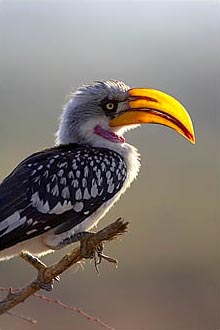 Eastern Yellow-Billed Hornbill
Samburu National Reserve, Kenya
Eastern Yellow-Billed Hornbill
Samburu National Reserve, Kenya
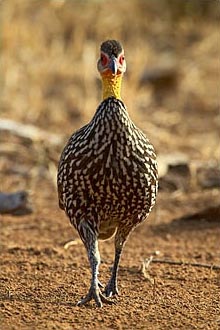 Yellow-Necked Spurfowl
Samburu National Reserve, Kenya
Yellow-Necked Spurfowl
Samburu National Reserve, Kenya
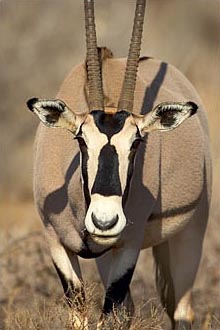 Biesa Oryx
Samburu National Reserve, Kenya
Biesa Oryx
Samburu National Reserve, Kenya
Next stop was one night at Lake Nakuru National Park, and it was my first time to this large lake known for the thousands of flamingos that feed there. I had a great time shooting the flamingoes in the early morning light. Other highlights include shooting white rhino (mother and calf) and olive baboons (youngsters and an infant).
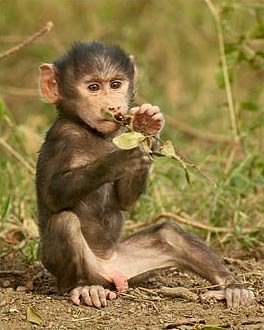 Infant Olive Baboon
Lake Nakuru National Park, Kenya
Infant Olive Baboon
Lake Nakuru National Park, Kenya
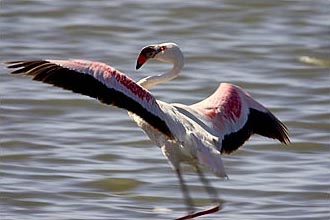 Lesser Flamingo Touching Down
Lake Nakuru National Park, Kenya
Lesser Flamingo Touching Down
Lake Nakuru National Park, Kenya
Then we spent eight nights in Masai Mara National Reserve which is part of the Serengeti ecosystem and is on the south-western border of the country. The first four nights were in the Lower Mara and the last four were in the Upper Mara. At this time of year, the famed migration of wildebeest and zebra puts the animals in the Lower Mara area. The major predators, lions, leopards, and cheetah, have it easy this time of year as the buffet-on-hoof comes through. The lion cubs below-left were being led by their mother to a wildebeest kill. The cub on the right found a strap in the grass, and proudly carried his new toy. The other cubs were jealous, and the one on the left was trying to steel it from the finder. Other high points were seeing a two-day-old elephant and some week-old lion cubs. The image of the young male lion (below right) is an example of bending the rules. Here, the light is coming from the side and slightly behind the subject. This makes the tall grass in the early morning light have a spectacular glow. The image of the Grant's gazelle is another image made with backlighting. The tall grass sparkles and provides a nice background to offset the darker subject.
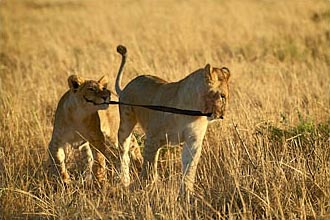 Lion Cubs and Strap
Masai Mara National Reserve, Kenya
Lion Cubs and Strap
Masai Mara National Reserve, Kenya
 Young Male Lion
Masai Mara National Reserve, Kenya
Young Male Lion
Masai Mara National Reserve, Kenya
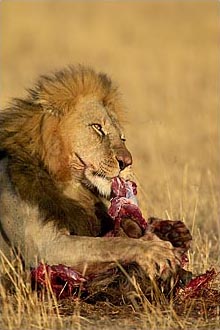 Male Lion Eating Breakfast
Masai Mara National Reserve, Kenya
Male Lion Eating Breakfast
Masai Mara National Reserve, Kenya
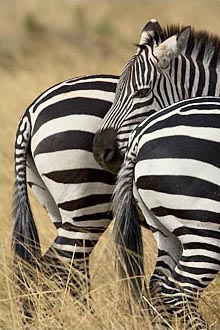 Common Zebra Trio
Masai Mara National Reserve, Kenya
Common Zebra Trio
Masai Mara National Reserve, Kenya
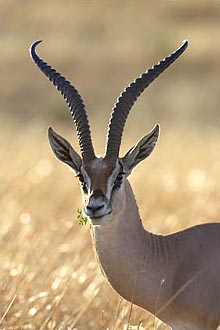 Grant's Gazelle Eating Breakfast
Masai Mara National Reserve, Kenya
Grant's Gazelle Eating Breakfast
Masai Mara National Reserve, Kenya
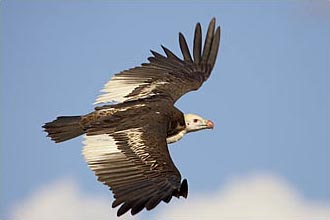 White-Headed Vulture
Masai Mara National Reserve, Kenya
White-Headed Vulture
Masai Mara National Reserve, Kenya
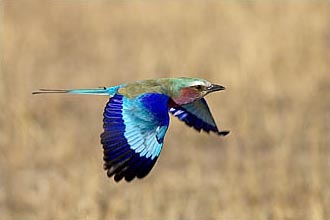 Lilac-Breasted Roller
Masai Mara National Reserve, Kenya
Lilac-Breasted Roller
Masai Mara National Reserve, Kenya
The highlight of the whole trip occurred in the Lower Mara where I was able to get my first good shots of a kill!! We had been watching a cheetah walk along the edge of a herd of wildebeest perpendicular to our vehicle, when suddenly the cheetah started trotting away from us into the herd. I figured that would be the end of the cheetah, because the herd was at the top of a hill and we couldn't get any closer to it. So, I changed my camera settings to shoot some pan-and-blur shots of the wildebeest that were now running perpendicular to our vehicle (Canon 1D Mk II, 500 f4 w/1.4x II teleconverter, ISO 100, f16, aperture priority). The next thing I knew, our guide yelled, "The cheetah's coming." Sure enough, it was running almost straight towards our vehicle in pursuit of a young wildebeest. I acquired the target and held the motor drive down as the cheetah kept coming and finally took down the wildebeest about 20 yds from our vehicle!!! Because the camera was set up for a relatively long exposure (1/45 sec in the left, and 1/20 sec in the right), the images have a surreal effect that definitely captures the blur of the chase which was literally over in seconds.
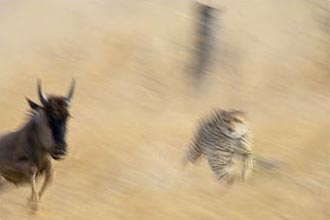 Cheetah Chasing a Young Wildebeest
Masai Mara National Reserve, Kenya
Cheetah Chasing a Young Wildebeest
Masai Mara National Reserve, Kenya
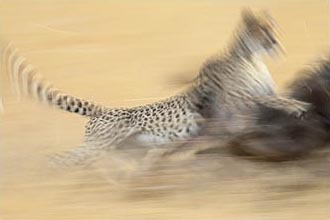 Cheetah Taking Down a Young Wildebeest
Masai Mara National Reserve, Kenya
Cheetah Taking Down a Young Wildebeest
Masai Mara National Reserve, Kenya
I'll let you know how the trip to South Africa goes when I return.
Take care, and happy shooting.
— James
James Hager Photography :: www.jameshagerphoto.com

 All of the images on this site are ©James Hager and are intended for viewing only. They are not to be
All of the images on this site are ©James Hager and are intended for viewing only. They are not to be
downloaded or reproduced in any way without the written permission of James Hager Photography.
The James Hager Photography photo safari to Kenya was very successful — everyone had a blast and got lots of great images.
First stop was four nights at Samburu National Reserve. It's roughly in the center of the country and provides a home for some species not found further south. One in particular is the Biesa oryx (below right). The yellow-billed hornbill (below left) was shot backlit to capture the glowing yellow bill as the light filtered through it. While "the rule" says to keep the sun at your back while shooting, sometimes a more effective image can be made when you break the rules.



Next stop was one night at Lake Nakuru National Park, and it was my first time to this large lake known for the thousands of flamingos that feed there. I had a great time shooting the flamingoes in the early morning light. Other highlights include shooting white rhino (mother and calf) and olive baboons (youngsters and an infant).


Then we spent eight nights in Masai Mara National Reserve which is part of the Serengeti ecosystem and is on the south-western border of the country. The first four nights were in the Lower Mara and the last four were in the Upper Mara. At this time of year, the famed migration of wildebeest and zebra puts the animals in the Lower Mara area. The major predators, lions, leopards, and cheetah, have it easy this time of year as the buffet-on-hoof comes through. The lion cubs below-left were being led by their mother to a wildebeest kill. The cub on the right found a strap in the grass, and proudly carried his new toy. The other cubs were jealous, and the one on the left was trying to steel it from the finder. Other high points were seeing a two-day-old elephant and some week-old lion cubs. The image of the young male lion (below right) is an example of bending the rules. Here, the light is coming from the side and slightly behind the subject. This makes the tall grass in the early morning light have a spectacular glow. The image of the Grant's gazelle is another image made with backlighting. The tall grass sparkles and provides a nice background to offset the darker subject.







The highlight of the whole trip occurred in the Lower Mara where I was able to get my first good shots of a kill!! We had been watching a cheetah walk along the edge of a herd of wildebeest perpendicular to our vehicle, when suddenly the cheetah started trotting away from us into the herd. I figured that would be the end of the cheetah, because the herd was at the top of a hill and we couldn't get any closer to it. So, I changed my camera settings to shoot some pan-and-blur shots of the wildebeest that were now running perpendicular to our vehicle (Canon 1D Mk II, 500 f4 w/1.4x II teleconverter, ISO 100, f16, aperture priority). The next thing I knew, our guide yelled, "The cheetah's coming." Sure enough, it was running almost straight towards our vehicle in pursuit of a young wildebeest. I acquired the target and held the motor drive down as the cheetah kept coming and finally took down the wildebeest about 20 yds from our vehicle!!! Because the camera was set up for a relatively long exposure (1/45 sec in the left, and 1/20 sec in the right), the images have a surreal effect that definitely captures the blur of the chase which was literally over in seconds.


I'll let you know how the trip to South Africa goes when I return.
Take care, and happy shooting.
— James
James Hager Photography :: www.jameshagerphoto.com


downloaded or reproduced in any way without the written permission of James Hager Photography.


